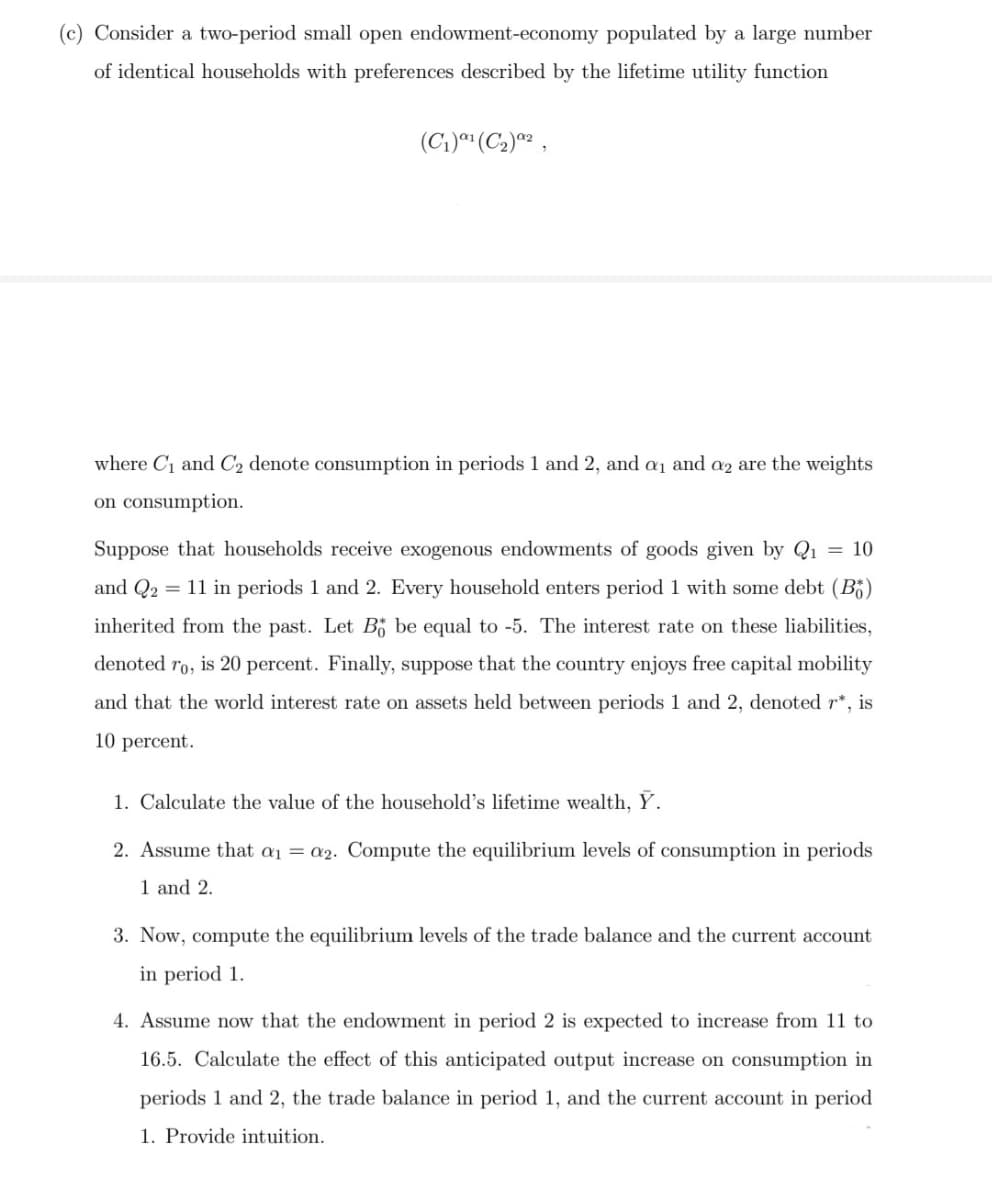(c) Consider a two-period small open endowment-economy populated by a large number of identical households with preferences described by the lifetime utility function (C1)°¹ (C2)2, where C1 and C2 denote consumption in periods 1 and 2, and a₁ and a2 are the weights on consumption. Suppose that households receive exogenous endowments of goods given by Q₁ = 10 and Q2 11 in periods 1 and 2. Every household enters period 1 with some debt (B) inherited from the past. Let B be equal to -5. The interest rate on these liabilities, denoted ro, is 20 percent. Finally, suppose that the country enjoys free capital mobility and that the world interest rate on assets held between periods 1 and 2, denoted r*, is 10 percent. 1. Calculate the value of the household's lifetime wealth, Y. 2. Assume that a₁ =a2. Compute the equilibrium levels of consumption in periods 1 and 2. 3. Now, compute the equilibrium levels of the trade balance and the current account in period 1. 4. Assume now that the endowment in period 2 is expected to increase from 11 to 16.5. Calculate the effect of this anticipated output increase on consumption in periods 1 and 2, the trade balance in period 1, and the current account in period 1. Provide intuition.
(c) Consider a two-period small open endowment-economy populated by a large number of identical households with preferences described by the lifetime utility function (C1)°¹ (C2)2, where C1 and C2 denote consumption in periods 1 and 2, and a₁ and a2 are the weights on consumption. Suppose that households receive exogenous endowments of goods given by Q₁ = 10 and Q2 11 in periods 1 and 2. Every household enters period 1 with some debt (B) inherited from the past. Let B be equal to -5. The interest rate on these liabilities, denoted ro, is 20 percent. Finally, suppose that the country enjoys free capital mobility and that the world interest rate on assets held between periods 1 and 2, denoted r*, is 10 percent. 1. Calculate the value of the household's lifetime wealth, Y. 2. Assume that a₁ =a2. Compute the equilibrium levels of consumption in periods 1 and 2. 3. Now, compute the equilibrium levels of the trade balance and the current account in period 1. 4. Assume now that the endowment in period 2 is expected to increase from 11 to 16.5. Calculate the effect of this anticipated output increase on consumption in periods 1 and 2, the trade balance in period 1, and the current account in period 1. Provide intuition.
Chapter17: Capital And Time
Section: Chapter Questions
Problem 17.1P
Related questions
Question

Transcribed Image Text:(c) Consider a two-period small open endowment-economy populated by a large number
of identical households with preferences described by the lifetime utility function
(C1)*" (C2)2
whe
C1 and C2 denote consumption in periods 1 and 2, and a1 and az are the weights
on consumption.
Suppose that households receive exogenous endowments of goods given by Q1 = 10
and Q2 = 11 in periods 1 and 2. Every household enters period 1 with some debt (B5)
inherited from the past. Let B be equal to -5. The interest rate on these liabilities,
denoted ro, is 20 percent. Finally, suppose that the country enjoys free capital mobility
and that the world interest rate on assets held between periods 1 and 2, denoted r*, is
10 percent.
1. Calculate the value of the household's lifetime wealth, Ý.
2. Assume that a1 = a2. Compute the equilibrium levels of consumption in periods
1 and 2.
3. Now, compute the equilibrium levels of the trade balance and the current account
in period 1.
4. Assume now that the endowment in period 2 is expected to increase from 11 to
16.5. Calculate the effect of this anticipated output increase on consumption in
periods 1 and 2, the trade balance in period 1, and the current account in period
1. Provide intuition.
Expert Solution
This question has been solved!
Explore an expertly crafted, step-by-step solution for a thorough understanding of key concepts.
Step 1: State the given information
VIEWStep 2: Find the value of household wealth
VIEWStep 3: Compute the equilibrium levels of consumption in periods 1 and 2
VIEWStep 4: Compute the equilibrium levels of the trade balance and the current account in period 1
VIEWStep 5: Calculate the effect of the anticipated output increase on consumption
VIEWSolution
VIEWStep by step
Solved in 6 steps with 18 images

Knowledge Booster
Learn more about
Need a deep-dive on the concept behind this application? Look no further. Learn more about this topic, economics and related others by exploring similar questions and additional content below.Recommended textbooks for you

